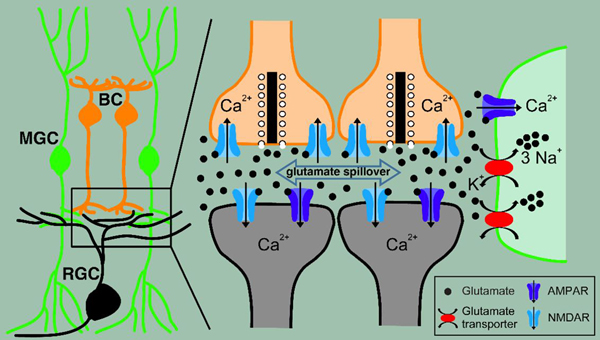Time:2019-06-04
The researchers from Dr. DU Jiulin’s lab at the Institute of Neuroscience, State Key Laboratory of Neuroscience, Center for Excellence in Brain Science and Intelligence Technology, Chinese Academy of Sciences, found that Müller glial cells (MGCs) participate in and modulate retinal waves via AMPA receptors and glutamate transporters on their own processes respectively, by using in vivo calcium imaging and electrophysiological recording in larval zebrafish.
During early development, spontaneous patterned neural activities propagate among neighboring retinal ganglion cells (RGCs), called retinal waves. After nearly three decades’ intensive investigation, it has been known that retinal waves can propagate via the optic nerve to the central visual system, and guide the activity-dependent refinement of visual topographic maps. However, how retinal waves are initiated and modulated are still mysterious. In a previous study of Du lab (Nature Communications 2016, 7:12650), the researchers reported for the first time that the axon terminals of bipolar cells (BCs) initiate glutamatergic retinal waves through a NMDA auto receptor-dependent mechanism.
MGCs, the principal glial cell in the vertebrate retina, span across the entire thickness of the retina. They form close contacts with retinal neurons, penetrate into neighboring synaptic clefts, and contribute to the maintenance of tissue structure. However, the function of MGCs in spontaneous retinal waves remains unclear. In the present study, using multiple in vivo techniques, including whole-cell recording and calcium imaging, the researchers found that MGCs of larval zebrafish exhibit spontaneous rhythmic wave-like activities, which have similar spatiotemporal properties to the waves in BCs and RGCs. Pharmacological experiments show these MGC waves are dependent on glutamatergic signaling from BCs. To further explore the underlying mechanism, the researchers combined whole-cell recording and pharmacological manipulations, and found that MGCs express glia-specific glutamate transporters and the α-amino-3-hydroxy-5-methyl-4-isoxazolepropionic acid (AMPA) subtype of glutamate receptors at their processes. Blockade of AMPA receptors abolished MGC calcium activities during retinal waves, whereas manipulation of glial glutamate transporters affected the occurrence of retinal waves. Taken together, MGCs can detect the existence of retinal waves through AMPA receptors and modulate the occurrence of retinal waves through glutamate transporters.
This work entitled “Müller Glial Cells Participate in Retinal Waves via Glutamate Transporters and AMPA receptors” was published in Cell Reports on June4.This work was mainly carried out by Dr. ZHANG Rongwei with help from DU Wenjie under the supervision of Dr. DU Jiulin. This work was supported by the National Natural Science Foundation of China (31771144), the Key Research Program of Frontier Sciences (QYZDY-SSW-SMC028), Strategic Priority Research Program (XDB32000000) and Youth Innovation Promotion Association of Chinese Academy of Sciences, Shanghai Municipal Science and Technology Major Project (18JC1410100, 2018SHZDZX05), China Wan-Ren Program, and Shanghai Leading Scientist Program.

Figure legend: The glutamate released from BC axon terminals diffuses in the IPL (inner plexiform layer) with a wave-like manner, and activates BCs and RGCs via ionotropic glutamate receptors and MGCs via glial glutamate transporters and AMPA receptors. AMPA receptors of MGCs mediate the calcium influx into MGCs, whereas glutamate transporters re-uptake extracellular glutamate and restrict glutamate spillover and the propagation of retinal waves.
 附件下载:
附件下载: